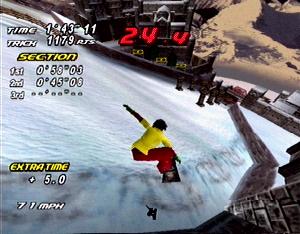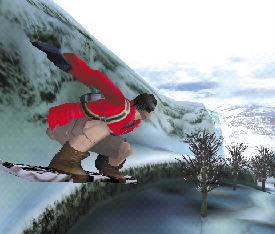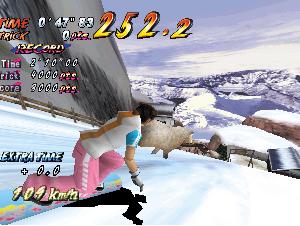Frozen legs and all.
The cold air nips at your cheeks as you stand atop the mountain. Peering down the slope reveals a craggy, obstacle-ridden path just begging to be boarded. It took you nearly 10 minutes to get up here. It will only take you 2 to get back down.
You strap yourself on to your trusty snowboard and edge towards the lip of the run. The sun gleans off the sleek surface of the slab of fiberglass under your feet. A bird whistles in the distance. Things grow silent…
The adrenaline rush of energy fills you to near bursting as you careen down the slope. Slicing back and forth across the hill, you approach your first jump. Steadying yourself, you prepare for a trick…and find that, to your dismay, you cannot move. You try to shift a bit to alter your direction, but for some reason your legs are locked into place. Your speed gathers, your hands tremble. The jump is meters away now, but the rigor mortis attacking your legs holds its iron grip. “Why are my legs frozen!” you wonder aloud. “And will that damn announcer shut up already!?” The last thing you hear is the sound of your own legs breaking (but that was one hell of a 720 Misty).
Welcome to the chilly world of Rippin’ Riders, the first snowboarding game to be released on the Dreamcast. This port of the Japanese game Cool Boarders Burrrn certainly has its moments, but is ultimately hampered by a wacky control scheme and the worst sound since fingernails on a blackboard.
The general idea of Rippin’ Riders is the same as every snowboard game
that has preceded it – race down a mountain while performing death-defying tricks. Yet thankfully, this game adds a few new twists on this tiring genre.
Most snowboard games have separate ‘Trick’ and ‘Time’ modes. Rippin’ Riders breaks the mold by incorporating both trick and time into every race. Achieving higher scores requires a balance between killer trick mastery and blazing speed. To add incentive, time is added for pulling off better tricks, and points are deducted for falls. This setup is a great scoring system that more snowboarding games should utilize, as it demands much more focus and a smoother overall run.
However, a smooth run is far from common. Rippin’ Riders is a difficult
game. This is due in part to the track design. There are initially 5 enormous runs and a half-pipe, though by beating these you can open up more. The length of the tracks is impressive, with most times exceeding two and a half real-time minutes. The implausible level design is cool – multiple paths and bizarre obstacles make each track a unique experience.
Another nifty addition is the multi-player. You can play against a friend via split screen in several different ways – most trick points, fastest time, etc. The coolest mode is ‘Line Versus,’ an interesting Battle game that rewards you for landing tricks by moving the split-screen dividing line over into your opponent’s space. The more tricks you land, the further the bar moves. Eventually, your opponent might find himself with a tiny smidgen of viewable screen area, while you enjoy a much wider panoramic.
Rippin’ Riders is a graphical mixed bag. The framerate is top notch and the viewable distance is impressive – if you see something on the horizon, you’ll actually reach it and pass it by. But despite the cool track design, the textures are bland, and you’ll find occasional clipping errors. In the end, this is just an adequate looking Dreamcast game.

Perhaps the biggest problem with Rippin’ Riders is the control scheme. To jump, you have to hold down the A-button. While holding down the button, you can hold the D-pad (or analog stick) in any direction. The longer both are held, the higher the jump and the more rotation you’ll get. Sounds easy, right? Unfortunately, this control has severe gameplay implications.
While holding down the jump button, you cannot steer your boarder. You get locked into one position until you release the A-button. This means that you need to have a good deal of time to set up jumps. The game moves fast, however, and you often will round a corner and quickly approach a jump point. And more often than not, you’ll hold down jump, lock yourself into place, and ram into the side of a mountain.
To add insult to injury, the actual amount of rotation is determined by how long you hold the D-pad. You don’t get any sort of meter to indicate how much you’ll turn, and you can only make very minor adjustments while in mid-air. This leads to constant over or under rotating during tricks. Pulling off a back flip takes frustrating amounts of time, patience, and impeccable timing.
Sounds bad? Why yes, they are. The announcer in Rippin’ Riders is, bar none, the most irritating person in the world. He rambles on incessantly about the quality of your boarding, repeating the same 5 or 6 comments ad nauseum. And the kicker is that YOU CANNOT TURN HIM OFF. That’s right. No ‘turn off retarded announcer’ option. D’oh!
Couple the bad announcer with the cheesy, repetitive techno tracks, and you’ll soon realize that the best option is to turn off the sound completely. If that doesn’t work, then I suggest reaching into your ears and ‘Rippin’ out your eardrums. Trust me, you do NOT want to hear this game.
When all is said and done, Rippin’ Riders just doesn’t quite make the cut. While offering several cool features, its rigid controls and terrible sound undermine those few bright spots and result in a merely average game. I’d love to give the announcer a kick in the ass, if I could only move my legs…

-
Great balance between tricks and time
-
Cool multiplayer
-
Bad control
-
Awful sound
-
So-so graphics







